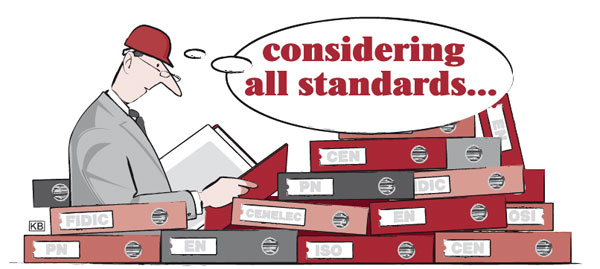
Although perceived as vague and uninteresting to the general public, standards are one of the most important issues for business. they make life easier not only for manufacturers but also organizations, managers and individual consumers. apart from being a source of technical specifcations, standards have become a means to spread and promote technology among average users.
Mimo, że znane jedynie wąskiej grupie ludzi, normy stanowią jeden z najważniejszych czynników wpływających na życie codzienne i działalność gospodarczą. nie są one bowiem jedynie zbiorem danych technologicznych, lecz w rezultacie jedną z dróg upowszechniania zdobyczy nauki wśród przeciętnych konsumentów.
What is a standard?
International standards are globally applicable agreements which constitute rules and characteristics for compatibility in technology, administration, services, etc. and are aimed at bringing both social and environmental benefts. Standards are developed by experts from various market sectors when there is an obvious need for standardisation in specifc areas of interest. In order to keep abreast of changing technology and requirements, the standards have to undergo regular reviews and be updated or withdrawn accordingly. When a particular standard is adopted, the product, service or procedure is subjected to a conformity assessment, which determines (by means of e.g. surveillance, auditing or accreditation) if the relevant requirements are followed and fulflled.
Why are standards necessary?
The application of standards results in increased quality, environmental friendliness, safety, reliability, efciency and compatibility of products and services. In today’s world of global business, standardisation facilitates production and cross-border trade whilst the adoption of uniform standards encourages the worldwide spread of technological and management innovations. International standards may partially infuence legislation in individual countries, which create equivalent health, safety and environmental regulations, as well as conformity assessment, based on a common technological and scientifc base. In terms of legislation, the standards play a particularly valuable role in controlling air, water and soil quality, emissions of gases and radiation and environmental aspects of products, i.e. their interaction with the environment. Te most noticeable result of the use of international standards is their contribution to the comfort and safety of consumers’ everyday life. When standards are present, the products on the market are safe, reliable and compatible with any other equipment and, therefore, customers are ofered a wider choice of good quality merchandise.
Examples of standards
Standards are present in virtually every aspect of life – standardised screws make repair and maintenance easier; common terminology facilitates technology transfer and advance; standardised telephone and banking cards infuence travel and communication; standardised danger warnings or documents can be understood by people speaking diferent languages; uniform test methods allow comparisons of products and processes. Without international metric standards, shopping, trade, science and technological development would all be hindered.
Institutions
The numerous worldwide standards are defned and maintained by non-governmental organisations, of which the leading ones are the ISO, the IEC, or the ITU. European standards bodies include CEN, CENELEC, ETSI, and the IRMM. Polish standardisations are strictly connected with European ones.
 Znajdź w tekście zwroty oznaczające:
Znajdź w tekście zwroty oznaczające:
a) oprócz, poza – a……..part f……..rom
b) o globalnym zastosowaniu – ……..glob a ……..lly a……..pplicable
c) mają na celu – are a……..imed a……..t
d) być na bieżąco – k……..eep a……..breast o……..f
e) skutkuje – ……..results ……..in
f) wkład w – ……..con……..tribution to
g) niemalże – v……..irtually
h) ocena zgodności – ……..conf……..ormity ……..asse……..ssment
 Dopasuj wyróżnione w tekście słowa do poniższych defnicji:
Dopasuj wyróżnione w tekście słowa do poniższych defnicji:
a) adding to something
b) capable of integration and operation with other elements in a system with no modifcation or conversion required
c) form or compose
d) given to approval, judgement, etc.
e) goods ofered for sale
f) inspection or examination
g) international, between countries
h) make easier
i) monitoring of behaviour
j) pass through
|
RZECZOWNIK |
CZASOWNIK |
PRZYMIOTNIK |
|
|
1
|
standard /standardisation |
||
|
2
|
require |
||
|
3
|
contribution |
||
|
4
|
managerial |
||
|
5
|
reliability |
||
|
6
|
application |
||
|
7
|
scientific |
||
|
8
|
withdraw |
||
|
9
|
adopt |
||
|
10
|
comparable |
{mospagebreak}
 Uzupełnij zdania stosując kolejno odpowiednią formę wyrazu z tabeli w zad. 3.
Uzupełnij zdania stosując kolejno odpowiednią formę wyrazu z tabeli w zad. 3.
1. Te industry is the largest user of materials – there was a need to harmonise and ……..standardise construction materials in the EU.
2. Our latest model should meet your ……..requirements exactly.
3. Improper excavation procedures ……..contributed to the death of a construction worker.
4. There are many diferent ways to improve ……..managerial skills.
5. Many businesses ……..rely on undocumented workers.
6. Architectural engineers ……..apply engineering principles to the construction, planning, and design of buildings and other structures.
7. Te Palace of ……..Science and Culture in Warsaw is the tallest building in Poland (230,68 metres).
8. Resistance of a nail to direct ……..withdrawal from a piece of wood is related to the density of the wood.
9. Te standard requires employers to ……..adopt work practice controls.
10. Many IT systems are ……..comparable in their structure and perform ……..comparable tasks.
Study tip!
Często spotykanym zjawiskiem przy przyswajaniu języka obcego jest spadek motywacji, a w konsekwencji zaprzestanie uczenia się. Oto kilka wskazówek jak kontrolować tempo nauki:
 Zachęcaj samego siebie, powtarzając zwroty takie jak: „co masz zrobić jutro, zrób dziś”, „nobody’s perfect”,itp.
Zachęcaj samego siebie, powtarzając zwroty takie jak: „co masz zrobić jutro, zrób dziś”, „nobody’s perfect”,itp.
 Zdobądź się na dokończenie raz rozpoczętego ćwiczenia.
Zdobądź się na dokończenie raz rozpoczętego ćwiczenia.
 Wynagradzaj siebie za osiągane postępy.
Wynagradzaj siebie za osiągane postępy.
 Wykorzystuj czas, w którym pracujesz najbardziej efektywnie.
Wykorzystuj czas, w którym pracujesz najbardziej efektywnie.
 Proś inne osoby o pomoc i zachętę.
Proś inne osoby o pomoc i zachętę.
 Wprowadź czas przeznaczony na naukę do rozkładu dnia i tygodnia, i trzymaj się tego.
Wprowadź czas przeznaczony na naukę do rozkładu dnia i tygodnia, i trzymaj się tego.
 Wyeliminuj wszystko, co cię rozprasza, i znajdź jak najlepsze miejsce do nauki.
Wyeliminuj wszystko, co cię rozprasza, i znajdź jak najlepsze miejsce do nauki.
 Wyznacz sobie realne cele.
Wyznacz sobie realne cele.
 Gdy motywacja spadła nieodwołalnie, zrób sobie przerwę w nauce, a gdy (niezawodnie) wróci, zabierz się do pracy ze zdwojoną siłą!
Gdy motywacja spadła nieodwołalnie, zrób sobie przerwę w nauce, a gdy (niezawodnie) wróci, zabierz się do pracy ze zdwojoną siłą!

Aneta Kapron
Artykuł zamieszczony
w „Inżynierze budownictwa”,
październik 2007.





